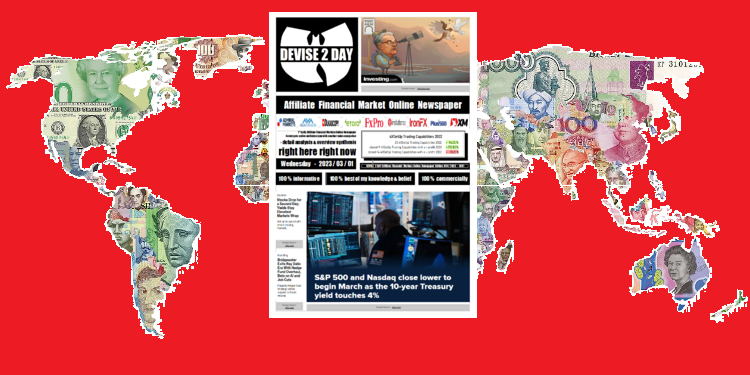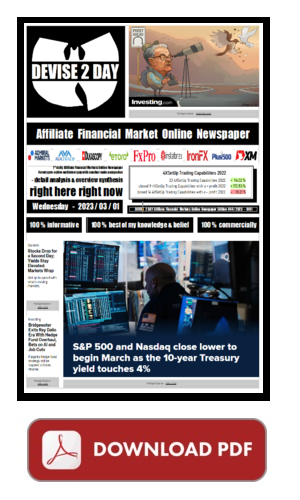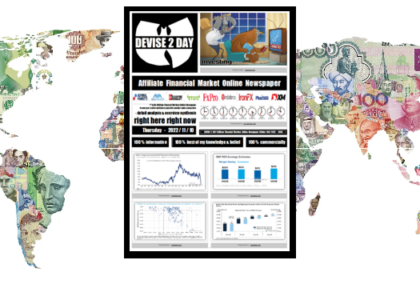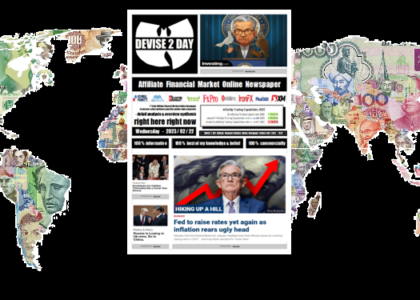
2023/03/01 (181.044) Technical Analysis – … & EUREX-FDAX1!
A Dance On The Razor Blade!
The DAX Future Is Trading Above 15000 Points…
Dax turns negative – expensive US yield curve is more attractive
The German stock market slipped into the red on Wednesday afternoon in the wake of a weakening Wall Street, further rising US bond yields and high inflation in Germany. After another setback, the Dax closed in late trading with a loss of 0.39 percent at 15,305.02 points. The MDax of medium-sized companies fell by 0.24 percent to 28,579.27 points. The EuroStoxx 50, the leading index in the euro zone, lost 0.5 percent to 4215.75 points. The French Cac 40 was down 0.5 percent. In contrast, the UK FTSE 100 rose 0.5 percent on strong commodity stocks. The New York Dow Jones Industrial fell to its lowest level in more than three months, but recovered again to a recent plus of 0.2 percent.
It had previously been announced that the mood in US industry – as measured by the ISM Purchasing Managers’ Index – brightened less than expected in February. Stockbrokers also pointed out that the yield on ten-year US government bonds has risen above the four percent mark for the first time since November. This is seen as a sign that the US Federal Reserve’s warnings about long-term higher interest rates are finally being heard on the market, it said. “The pressure of further rising yields on the US bond market is currently nipping any emerging positive momentum on Wall Street in the bud, and the German market is finding it difficult to escape this pull,” commented analyst Konstantin Oldenburger from CMC Markets. According to initial calculations, German consumer prices in February were 8.7 percent higher than in the same month last year. The expected decline in the rate did not materialize, wrote Jörg Zeuner, chief economist at asset manager Union Investment. The current inflation data, together with the higher figures from France and Spain, deepened the concerns of the European monetary authorities. Among the individual values, the shares of Siemens Energy as the Dax leader rose by 3.1 percent. Analyst Akash Gupta from US bank JPMorgan praised the withdrawal of wind power subsidiary Siemens Gamesa from the stock market as an important step towards a simplified group structure. The expert assumes that the focus will once again be on the optimization potential and the opportunities in the energy transition.
Meanwhile, the reporting season for companies entered a new round. Beiersdorf earned significantly more thanks to good demand last year. However, the fact that the consumer goods group only wants to keep its dividend constant caused resentment: the shares had fallen by three and a half percent in the meantime before they recovered somewhat and ultimately fell by 0.5 percent. The sporting goods manufacturer Puma expects growth to slow down after record sales last year. The papers fell as the weakest value in the MDax by 6.8 percent. ProSiebenSat.1 shares fell 3.4 percent. The media group is postponing the presentation of the annual and consolidated financial statements and possibly also the general meeting at short notice. The reason for this are regulatory issues in connection with the business of Jochen Schweizer mydays, which essentially consists of the sale of vouchers. Outside of the major indices, the GK Software shares shot up by almost 30 percent to EUR 188.20. The Saxon group is about to be sold. The Japanese IT giant Fujitsu wants to take over the retail cloud provider and is offering investors 190 euros per share.
DAX slips below 15,400 points: inflation data alienates investors
February consumer prices at 8.7 – beating expectations of 8.5 percent
DAX investors went into reverse again on Wednesday afternoon after the publication of new inflation data for the Federal Republic. The fact that inflation was higher than expected in February is feeding the smoldering interest rate fantasies in investor circles. According to the IG indication, the Frankfurt stock exchange barometer is just below the 15,400 mark again shortly before Wall Street opens. Consumer prices for Germany were 8.7 percent in February and thus significantly higher than expected. As in January, goods and services climbed an average of 8.7 percent year-on-month, as the Federal Statistical Office announced on Wednesday in an initial estimate. Compared to the previous month, inflation rose by 0.8 percent. Energy prices rose by 19.1 percent in February compared to February 2022. In January, however, prices were still 23.1 percent above the previous year’s value. Overall, a decrease in price pressure to 8.5 percent was expected in advance.
Will March bring new dynamics?
Yesterday, the DAX was able to confirm the stabilization initiated at the beginning of the week. After last Friday’s trailing edge – including an extremely high trading volume – we still consider this development to be very important. The German standard values remained within the high-low range of the weekly close for the second time in a row. As a result, a double inner bar is created. The bottom line is that the short-term holding zone at 15,200 points continues to exist, while in the long term the catchment area between 15,000/14,800 points is significantly more relevant. Here, the stock barometer has marked highs and lows with great regularity over the past two years. In addition, the 50-day smoothing (currently at 14,951 points) is also running in this haze. On the upside, on the other hand, an increase above the previous week’s high (15,553 points) would help the DAX® back on the road to success and probably give the starting signal for an end to the sliding zone of the last few weeks. As is so often the case, the view over the large pond probably provides an important orientation aid. Here it is still crucial that the S&P 500® defends the average of the last 200 days (currently at 3,940 points).
The lethargic February is finally history, it remains to be hoped that there will be more trend movements in the leading German index to trade again in the calendar month of March. However, the start of the new month was initially based on the pattern of the past trading days – a gap opening (upwards) and then no follow-through in the gap direction. Although the current chart structures still leave a lot to be desired, it remains to be seen that the bears gambled away their chances due to last Monday’s strong rally. A breakout above the short-term downtrend line on the hourly chart would be interpreted as a pro-cyclical bullish signal. In that case, a renewed attempt towards 15,650 points and higher would be favoured. Until then, a continuation of the sideways movement of the past few weeks can be expected. Procyclical sell signals only appear below 15,210 points.
Last But Not Least,
Let`s Get An Overview About The Most Important Economic Data
Which Drives The Dax And/Or The Other European Stock Markets Last Days
German Inflation Holds at 8.7%, Well Above Target
Germany’s consumer price inflation remained unchanged at 8.7 percent year-on-year in February 2023, not far from a peak of 8.8 percent seen in October and November and above market expectations of 8.5 percent, a preliminary estimate showed. It was also well above the European Central Bank’s target of 2.0 percent, and came on the heels of robust labor market data released earlier, which could mean the European Central Bank might stick to its current policy tightening campaign. Services inflation accelerated to 4.7 percent in February from 4.5 percent in January, with rent prices advancing 2.0 percent, the same pace as the month before. Meanwhile, goods inflation eased slightly to 12.4 percent from 12.7 percent, as a slowdown in energy inflation (19.1 percent vs 23.1 percent) partially offset a sharper increase in the cost for food (21.8 percent vs 20.2 percent). On a monthly basis, consumer prices advanced 0.8 percent in February, also above consensus of a 0.6 percent rise.
Germany 10-Year Bond Yield Continues to Rise to Hit Fresh 2011-Highs
Germany’s 10-year bond yield rose for a fourth straight session to above 2.7% on Wednesday, a fresh high since July of 2011, amid signs inflation reaccelerated in Europe, raising bets that interest rates will stay higher for longer. Preliminary inflation figures for France and Spain came in higher than expected and prices in North-Rhine Westphalia, the most populous region of Germany also rose at a faster pace. The peak rate for the benchmark deposit facility is now seen at 4% in February 2024, compared to 3.9% seen on Monday and 3.5% in July 2023, projected a few weeks ago. Meanwhile, ECB President Lagarde has recently told India’s Economic Times that “there is every reason to believe that we will do another 50 basis points in March” while Chief Economist Philip Lane told Reuters that the central bank may hold borrowing costs at a high level for some time.
Germany Manufacturing PMI Revised Lower in February
The S&P Global/BME Germany Manufacturing PMI was revised slightly lower to 46.3 in February of 2023 from a preliminary of 46.5, pointing to another sharp contraction in factory activity which now extended for an eighth month. A rapid improvement in supplier delivery times and a decline in stocks of purchases were the main drags while output rose for the first time in nine months as constraints on production from supply-chain bottlenecks showed further signs of easing. At the same time, the decline in new orders slowed, employment picked up, average prices paid for purchases fell for the first time since Sep.`20 and output price inflation eased to the weakest for two years. Finally, manufacturers’ expectations towards future output improved further to 12 months high.
German Jobless Rate Unchanged at 5.5%Germany Unemployment Rate
The seasonally adjusted jobless rate in Germany stood at 5.5 percent in February 2023, unchanged for a sixth consecutive month and in line with market expectations. The latest reading suggested the labor market remained resilient despite weak demand due to high inflation and rising borrowing costs. Still, the rate neared its highest level since August 2021, as the number of unemployed increased slightly by 2 thousand to 2.51 million. Year-on-year, the number of unemployed increased by 192 thousand.
European Shares Gain Helped by China’s PMI DataGermany Stock Market
European shares held onto early gains on the first trading session of March, with the STOXX 600 adding 0.1% and Germany’s DAX 40 advancing 0.4% as investors welcomed better-than-expected factory activity numbers out of China. Elsewhere, sentiment was hit by a PMI survey pointing to an eighth month of decline in Eurozone’s manufacturing output and the prospect of another big rate hike from the European Central Bank later this month to combat high inflation. On the corporate front, Euronext withdrew its €5.5 billion offer for fund distribution firm Allfunds, while BNP Paribas was under pressure on news that Belgium was preparing the sale of a third of its 7.8% equity stake the euro-zone’s biggest bank. Nivea maker Beiersdorf forecast organic sales growth to slow after a bumper 2022, while logistics group Kuehne und Nagel reported a 43% drop in Q4 operating profit and Just Eat Takeaway.com swung to a small 2022 core profit.
good morning, good day, and/or good night
at whatever time, wherever you are !
right here right now :


















